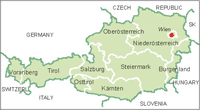
About Styria
 Styria, in German - Steiermark , is a province (1991 pop. 1,184,593), 6,324 sq mi (16,379 sq km) in central and SE Austria. Graz is the capital. Bordering on Slovenia in the south, Styria is predominately mountainous, with many forests, pastures, and meadowlands. The province is drained by the Mur, Enns, and Raab rivers. It is the chief Austrian mining district (iron ore, lignite, salt, graphite, gypsum, talc, and magnesite) and has a well-developed metals industry, particularly in the north, near the Erzberg. The province also produces paper, cellulose, chemicals, leather, textiles, and food products. Graz is a center of motor-vehicle assembly. Cattle, horses, and poultry are raised, and forestry is an important occupation. There are many Alpine resorts, and tourism is a major source of revenue.
Styria, in German - Steiermark , is a province (1991 pop. 1,184,593), 6,324 sq mi (16,379 sq km) in central and SE Austria. Graz is the capital. Bordering on Slovenia in the south, Styria is predominately mountainous, with many forests, pastures, and meadowlands. The province is drained by the Mur, Enns, and Raab rivers. It is the chief Austrian mining district (iron ore, lignite, salt, graphite, gypsum, talc, and magnesite) and has a well-developed metals industry, particularly in the north, near the Erzberg. The province also produces paper, cellulose, chemicals, leather, textiles, and food products. Graz is a center of motor-vehicle assembly. Cattle, horses, and poultry are raised, and forestry is an important occupation. There are many Alpine resorts, and tourism is a major source of revenue.  Styria was originally settled by Celts and later was part of Roman Noricum and Pannonia. It was made a duchy in 1180 and in 1192 passed to the Austrian house of Babenberg. Ottocar II of Bohemia successfully contested it with Bela IV of Hungary, but in 1278, at the battle of Marchfeld, Ottocar was defeated and killed by the forces of Rudolf I of Hapsburg. Rudolf declared (1282) Styria hereditary Habsburg possession. By the Treaty of Saint-Germain (1919) Styria's southern portion was ceded to Yugoslavia and is now part of Slovenia.
Styria was originally settled by Celts and later was part of Roman Noricum and Pannonia. It was made a duchy in 1180 and in 1192 passed to the Austrian house of Babenberg. Ottocar II of Bohemia successfully contested it with Bela IV of Hungary, but in 1278, at the battle of Marchfeld, Ottocar was defeated and killed by the forces of Rudolf I of Hapsburg. Rudolf declared (1282) Styria hereditary Habsburg possession. By the Treaty of Saint-Germain (1919) Styria's southern portion was ceded to Yugoslavia and is now part of Slovenia.Graz ,the capital of Styria, is located on the Southern outskirts of the Alps, a very pleasant landscape of smaller hills (similar to Salzburg).
This allowed the early counts of Styria and later the Dukes of Austria to build a castle quite easily defended on the Schlossberg (meaning: Castle Mountain). Thereby, Graz had a key position for controlling the Austrian lands South of the Alps - towards "sensitive" areas like the Turkish Empire or the Balkan. Graz was also heavily involved in religious struggles during the days of the counter-reformation.
 Back to top
Back to top


 Romana
Romana English
English











